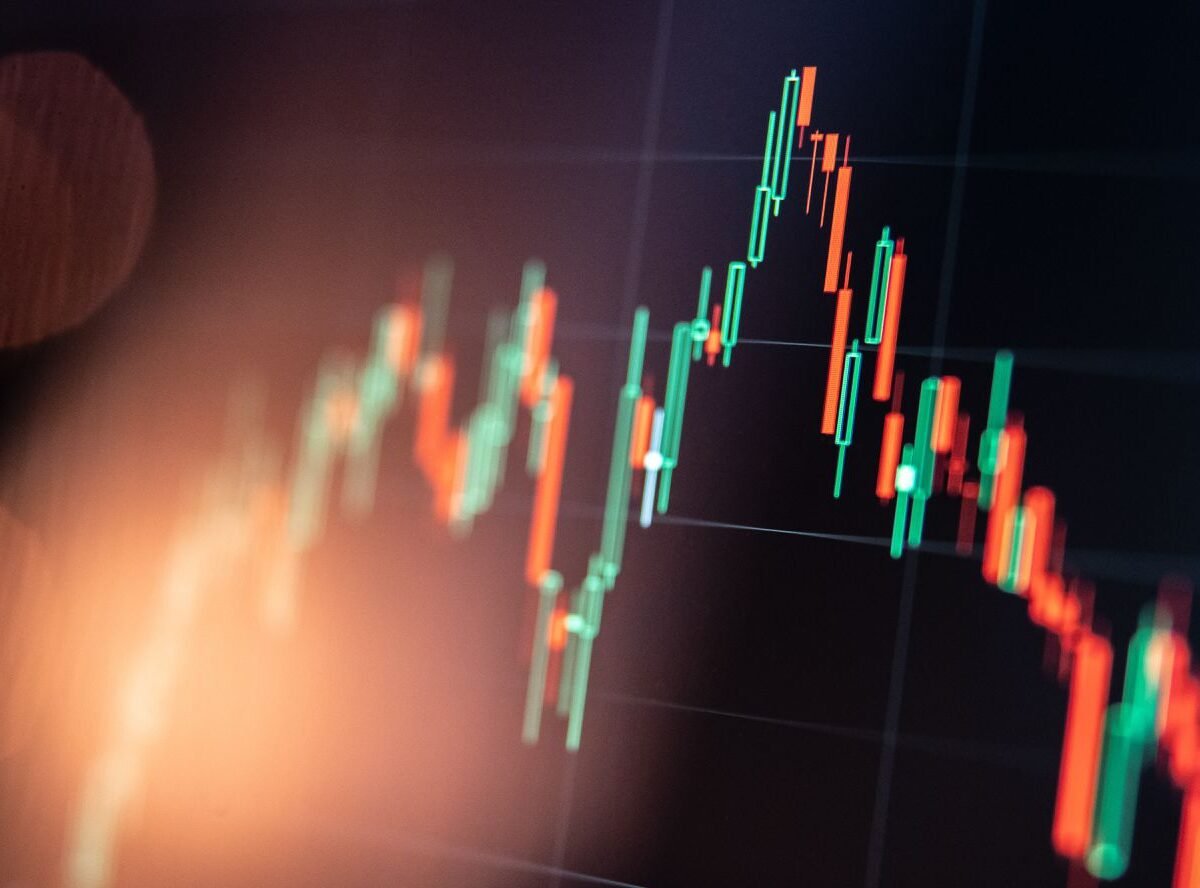Fractals are repeating patterns found in financial markets that help traders make sense of chaotic price movements. They are used to identify potential reversal points and spot emerging trends, offering valuable insights into market behavior. They also reflect market psychology and tie closely to chaos theory, which explains how small changes can create big effects in complex systems. In this article, we explore how to apply fractal analysis and techniques to strengthen your trading strategies.
Key Takeaways
- Fractals are simple five-bar reversal patterns that help identify potential turning points in market movements.
- A bearish fractal has the highest high in the middle, while a bullish fractal has the lowest low in the middle.
- Fractals are lagging indicators and should be used alongside other tools to confirm trends.
- Fractal geometry helps traders understand complex market patterns, drawing from Benoit Mandelbrot’s mathematical theories.
- Combining fractals with Fibonacci retracement levels can improve the accuracy of predicting price reversals.
What Are Fractals in Investing?
Traders—those working with the price history of stocks, etc., to try to predict price changes—may use fractals in technical analysis to make decisions about market entry and exit points, to set stop-loss orders, and to help identify support and resistance levels. They are often used with other technical analysis tools to confirm the trends they see developing.
The theory of fractals in technical analysis posits that financial markets are chaotic, but within that chaos, patterns emerge that are not random. The idea is derived from the broader mathematical theory of fractals, introduced by Benoit Mandelbrot in the 1970s. Mandelbrot’s work suggested that many natural phenomena exhibit fractal characteristics. These include self-similarity across different scales, meaning the same patterns repeat at various sizes and frequencies within a larger grand pattern. Mandelbrot applied fractals to market changes, critiquing modern portfolio theory for ignoring the potential for catastrophic events, something that brought more attention to his work after the 2007-8 financial crisis.
In financial markets, the theory posits that these repeating patterns, or fractals, can indicate psychological points of reversal where price trends are likely to change direction. The premise is that market movements are influenced by traders’ reactions to price changes, which tend to follow repetitive cycles because of human nature and collective memory. This cyclical behavior then creates patterns that can be recognized and used to predict market changes. Mandelbrot, in writing that’s often rare for a mathematician, is very clear on this point:
In finance, this [fractal] is not a rootless abstraction but a theoretical reformulation of a down-to-earth bit of market folklore— namely, that movements of a stock or currency all look alike when a market chart is enlarged or reduced so that it fits the same time and price scale. An observer then cannot tell which of the data concern prices that change from week to week, day to day or hour to hour. This quality defines the charts as fractal curves and makes available many powerful tools of mathematical and computer analysis.
As such, if we can identify more macro trends (week to week), perhaps we can then apply that knowledge to when we see those trends forming within shorter periods (hour to hour or day to day), the same way we can look at a leaf in our hand, then put it under a microscope and look for the same pattern at much smaller levels. If we can do that, we will have a powerful tool for knowing when to enter or exit positions.
But this shouldn’t be taken to mean that patterns will simply repeat from longer time scales to smaller ones. As Mandelbrot puts it, fractals “do not come closer to forecasting a price drop or rise on a specific day based on past records.” Instead, “they provide estimates of the probability of what the market might do and allow one to prepare for inevitable sea changes. The new modeling techniques are designed to cast a light of order into the seemingly impenetrable thicket of the financial markets.”
One way to find this order is by applying the observation that chart patterns often have a central high or low point flanked by two lower or higher points on either side. This arrangement suggests a pivot or balance point between buyers and sellers, which could indicate potential reversal points where a price has gone down far enough and will go back up or has risen as high as it will go and will go back down.
While fractal theory offers compelling ways to understand the market, it’s important to note that many factors influence the market, and no theory can predict price changes with certainty. For this reason, traders often use fractals with other analysis tools to develop a more comprehensive trading strategy.
Fractal Patterns in Technical Analysis
In trading, fractal patterns are used to identify potential reversal points in the market, based on the theory that markets move in predictable patterns that repeat over time. These patterns can be observed in the price charts of equities and other financial securities. Here are some ways fractal patterns are used in trading:
- Basic fractal pattern: The most fundamental fractal pattern consists of a series of five bars or candlesticks, with the middle one being the highest (in a bearish fractal) or the lowest (in a bullish fractal) and flanked by two lower highs (in a bearish fractal) or two higher lows (in a bullish fractal). This pattern suggests a potential for price reversal when market sentiment may shift from bullish to bearish or vice versa.
- The alligator indicator: This uses fractal geometry to help traders identify the start of a trend. It consists of three smoothed moving averages that help to spot trend formation and direction.
- Fractal breakouts: This pattern occurs when the price action breaks through the high or low of a previously identified fractal. Traders often use this to see if a trend is continuing or not.
- Complex fractal patterns: Beyond the basic fractal structures, traders and analysts sometimes identify more complicated patterns that incorporate fractals as part of larger chart formations, such as Elliott Wave patterns (based on the view that price charts have repeated waves) or Fibonacci retracements (classic ratios used to see the limits of waves and other patterns). These patterns rely on the fractal nature of markets to predict price movements within larger trends.
Essential Components of Fractal Patterns
Fractal patterns have key components that traders look for to identify them:
- They are composed of five or more price bars.
- The central price bar is significantly higher or lower than the bars on either side.
- For bearish fractals, the middle bar has the highest high.
- For bullish fractals, the middle bar has the lowest low.
- Two price bars on either side of the middle bar form lower highs (bearish) or higher lows (bullish).
These form the basic fractal pattern. Traders keep an eye out for this sequence of price action to spot potential reversal points. The pattern isn’t confirmed until the two bars on either side are formed, so there is an inherent lag to the signals you can get from fractal signals. However, once the pattern is completed, the fractal might indicate a reversal point in the market.
The fractals below are two examples of perfect patterns. Note that many other less-perfect patterns can occur, but this basic pattern should remain for the fractal to be considered valid.
How to Use Fractals in Trading
Most charting platforms now provide fractals as trading indicators. Thus, traders don’t need to hunt for the pattern. Apply the indicator to the chart, and the software will highlight all the patterns. When doing this, traders notice an immediate problem: this pattern occurs frequently.
Fractals are best used with other indicators or forms of analysis. A common indicator for confirming a fractal pattern is the alligator, which uses multiple moving averages. The chart below shows a long-term uptrend with the price staying predominantly above the alligator’s teeth, the middle moving average. Since the trend is up, bullish signals could be used to generate buy signals.
Sometimes, switching to a longer time frame can reduce the number of fractal signals, allowing for a cleaner chart that is easier for spotting trading opportunities.
The obvious drawback here is that fractals are lagging indicators. A fractal can’t be drawn until two days into the reversal. However, the most significant reversals will continue for more bars, benefiting the trader. Once the pattern occurs, the price is expected to rise following a bullish fractal or fall following a bearish fractal.
Identifying Bullish Fractals
A bullish fractal occurs when there is a pattern with the lowest low in the middle and two higher lows on each side. This indicates a potential bottom and reversal point to the upside.
Traders will look to buy when a bullish fractal appears, with a stop loss below recent lows. They expect prices to rise once the bullish fractal finishes forming.
Bullish fractals are most important when they form along known support levels or after a market pullback during an uptrend. They give traders a sign that the market may bounce back upward.
Recognizing Bearish Fractals
A bearish fractal is a pattern with the highest high in the middle and two lower highs on each side. This signals a potential peak and a reversal downward.
Traders will look to sell short or exit long positions when a bearish fractal takes shape, with a stop loss above recent highs. They assume prices will start declining when the bearish fractal pattern finishes forming.
As with the bullish fractal pattern, bearish fractals are most noteworthy when they occur near recognized resistance or after a bounce inside a longer downtrend. They indicate the market may be heading lower.
Tip
A bearish fractal is typically drawn on a chart with an up arrow above it, which can be confusing (since bearish markets don’t increase in value). Bullish fractals are drawn with a down arrow below them. Therefore, if using fractals in an overall uptrend, look for the down fractal arrows (if using a fractal indicator in most charting platforms). If looking for bearish fractals to trade in a larger downtrend, look for upward fractal arrows.
Combining Fractals With Fibonacci Retracements
One strategy when using fractals is to pair them with Fibonacci retracement levels. These are horizontal support and resistance lines that indicate potential reversal points in a market. They are based on the key Fibonacci ratios of 0%, 23.6%, 38.2%, 50%, 61.8% and 100%.
A challenge of using fractals on their own is determining which time is significant. Similarly, when using Fibonacci retracements on their own, the difficulty lies in deciding which level will hold as support or resistance. By combining the two, traders can narrow down the options: a trade is considered only when a fractal pattern forms at or near a key Fibonacci retracement level, indicating a higher probability of a price reversal.
Let’s use an example. Suppose an aggressive trader focused on the 61.8% retracement of a bull market to buy into pullbacks. Rather than unthinkingly buying every time this level is reached, the trader would first wait for a bullish (downward pointing) fractal to emerge at or near 61.8%. This would give the trader more confirmation that a reversal back upward could be underway.
The chart in the example below illustrates this setup. A clear bullish fractal forms right around the 61.8% Fibonacci line on a pullback within an uptrend. This means there’s a high probability that the pullback ends, and a trader should be confident entering a long position. The fractal does lag slightly, so a trader would typically put a stop loss if it goes below the recent swing’s low as insurance. Since the overall trend is up, profits can be taken once a bearish fractal suggests the rally is pausing. This demonstrates how using both tools at once makes it clearer when to enter and exit a position.
Integrating Fractals With Other Trading Indicators
Another common combination is to use fractals with the “alligator” indicator, which uses smoothed moving averages to generate trading signals. The key is watching when the “jaws” (often indicated on charts by a blue line) cross the “teeth” (a red line). When using fractals with the alligator, traders first check that the alligator alignment matches the expected trend direction. For example, in an upward-trending market, the blue jaws line should be above the red teeth line. Then, when looking for bullish fractals to trade, traders check that the alligator continues to signal an uptrend when a fractal forms. This added step with the alligator helps better confirm that the fractal reversal aligns with the prevailing market direction.
In addition to Fibonacci retracements and the alligator, here are other common tools and indicators used with fractals:
- Moving averages: Fractals can be used to trade bounces off key moving averages like the 50-day or 200-day. The moving averages define the overall trend.
- Price action analysis: Analyzing candlestick patterns, support and resistance lines, and the market overall to trade only in the direction of the broader market trends.
- Momentum oscillators: Oscillators like the relative strength index can better define overbought/oversold levels from which fractal reversals emerge.
- Volume analysis: Adding volume confirms true reversal fractals. Volume should increase when the fractal signals are valid.
Advantages and Disadvantages of Using Fractals
Fractal Pattern Pros and Cons
Pros
-
Easy to identify and understand
-
Widely applicable across markets and time frames
-
Included in many charting platforms
Fractals are visually intuitive and easy to spot on price charts, making them accessible to traders of all experience levels. They can be applied to various financial markets, including stocks, forex, and commodities, and across different time frames, including short-term and long-term trading. This makes them quite versatile. Most modern charting tools in many brokerage platforms will also include fractals in their indicator list, allowing for easy analysis without custom coding or software.
There are, however, certain drawbacks. Fractals are based on past prices and form only after a reversal has begun. This means they lag behind the present market movements, potentially leading to missed opportunities or late entries. Because of the frequent appearance of fractal-like patterns, they can also produce false signals. This means they need to be used with other indicators to confirm and filter out unreliable signals.
In addition, while fractals in longer time frames are considered more reliable, they also generate signals less frequently, which might not suit traders looking for more frequent trading opportunities.
Can Fractals Really Predict Future Price Movements?
While fractals can provide insights into potential market reversals, they can’t guarantee future market moves. Instead, fractals are a way to understand the present market and possible points of exhaustion in a trend. Traders typically use fractals only with other technical analysis tools, such as moving averages or momentum indicators, to increase their reliability.
What Is the Rationale Behind Fractals in Trading?
The rationale behind using fractals lies in their ability to reflect the collective behavior and sentiment of the market. Each fractal pattern is meant to represent a moment where buyers or sellers temporarily gain dominance, leading to a potential price reversal. Recognizing these patterns is based on the idea that market participants tend to react in similar ways to similar market conditions, creating repetitive patterns. Fractals, therefore, help traders anticipate potential market moves based on historical behavior, leveraging the psychological tendencies of fear, greed, and herd behavior that often drive the market.
What Is the Connection Between Fractals and Chaos Theory?
Chaos theory is a field of mathematics that studies complex, nonlinear dynamic systems. These are systems that appear random but contain underlying patterns and order. Financial markets are often said to have this character: seemingly chaotic but with an inherent order. In chaos theory, fractals reveal orderly structures in chaotic data sets and environments.
In financial markets, price charts can look very chaotic and random from far away. However, on closer inspection, a repeated behavior seems to emerge. These repetitive patterns at different scales are akin to fractals. So, while day-to-day price action can seem unpredictable, zooming into smaller time frames uncovers similar fractal structures. These fractals exist within all the market noise and volatility.
What Is the Fractal Market Hypothesis?
The fractal markets hypothesis (FMH) is an alternative theory to the efficient market hypothesis proposed by market technician Ed Peters in the 1990s. It aims to explain and model some of the complex dynamics seen in financial markets by trying to understand the order behind the apparent randomness. Rather than assuming perfect efficiency, the FMH says market stability emerges from diverse investor strategies and time frames. Trends occur as information cuts across different time scales, creating patterns.
The Bottom Line
Fractals are used to identify possible reversal points in securities’ prices. These patterns are based on a series of five consecutive bars on a chart. The highest or lowest point in a fractal pattern, which is the central bar, suggests a potential reversal. Bearish fractals indicate potential downtrends in the market, while bullish fractals may signal uptrends in the market. Traders should understand how fractals work and consider using them with other tools to make better, well-informed decisions.





